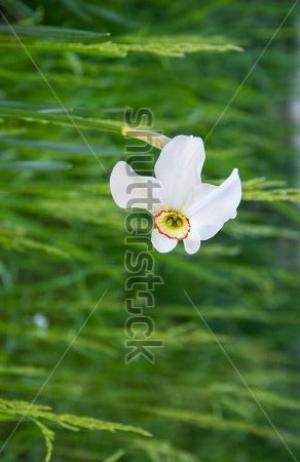Poet's daffodil
(Narcissus poeticus poeticus)

Description
Narcissus poeticus (poet's daffodil, poet's narcissus, nargis, pheasant's eye, findern flower, and pinkster lily) was one of the first daffodils to be cultivated, and is frequently identified as the narcissus of ancient times (although Narcissus tazetta and Narcissus jonquilla have also been considered as possibilities). It is also often associated with the Greek legend of Narcissus. It is the type species of the genus Narcissus and is widely naturalized in North America. The flower is extremely fragrant, with a ring of petals in pure white and a short corona of light yellow with a distinct reddish edge. It grows to 20 to 40 cm (7.9 to 15.7 in) tall. t is commonly known as 'pheasant's-eye daffodil' or 'poet's narcissus' (in the UK), 'claudinette', 'narcisse', 'narcisse poetes' and 'oeil de faisan' (in France), 'weiße Narzisse' (in German), 'narciso (in Italian and Spanish) and 'narciso blanco' and 'trompón' (in Spanish) and 'pingstlilja' (in Swedish).[6] It is also occasional y known as 'Pinkster lily'. It was published and described by Carl Linnaeus in his book Species Plantarum on page 289 in 1753. It was verified by United States Department of Agriculture and the Agricultural Research Service on 9 July 2015. In medicine, it was described by Dioscorides in his Materia Medica as "Being laid on with Loliacean meal, & honey it draws out splinters". James Sutherland also mentioned it in his Hortus Medicus Edinburgensis. In Korea, it is used to treat conjunctivitus, urethritis and amenorrhoea.
Taxonomic tree:







